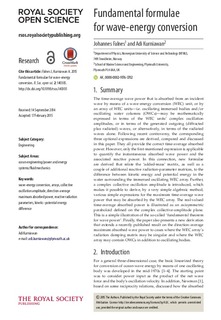| dc.contributor.author | Falnes, Johannes | |
| dc.contributor.author | Kurniawan, Adi | |
| dc.date.accessioned | 2019-11-13T10:35:54Z | |
| dc.date.available | 2019-11-13T10:35:54Z | |
| dc.date.created | 2015-03-23T14:51:16Z | |
| dc.date.issued | 2015 | |
| dc.identifier.citation | Royal Society Open Science. 2015, 2 (3), . | nb_NO |
| dc.identifier.issn | 2054-5703 | |
| dc.identifier.uri | http://hdl.handle.net/11250/2628155 | |
| dc.description.abstract | The time-average wave power that is absorbed, from an incident wave, by means of a wave energy conversion (WEC) unit, or by an array of WEC units--i.e. oscillating immersed bodies and/or OWCs--may be mathematically expressed in terms of the WEC units' complex oscillation amplitudes, or in terms of the generated outgoing (diffracted plus radiated) waves, or alternatively, in terms of the radiated waves alone. Following recent controversy, the corresponding three optional expressions are derived, compared, and discussed in the present paper. They all provide the correct time-average absorbed power. However, only the first-mentioned expression is applicable to quantify the instantaneous absorbed wave power and the associated reactive power. In this connection, new formulae are derived that relates the "added-mass" matrix, as well as a couple of additional reactive radiation-parameter matrices, to the difference between kinetic energy and potential energy in the water surrounding the immersed oscillating WEC array. Further, a complex collective oscillation amplitude is introduced, which makes it possible to derive, by a very simple algebraic method, various simple expressions for the maximum time-average wave power that may be absorbed by the WEC array. The real-valued time-average absorbed power is illustrated as an axisymmetric paraboloid defined on the complex collective-amplitude plane. This is a simple illustration of the so-called "fundamental theorem for wave power". Finally, the paper also presents a new derivation that extends a recently published result on the direction-average maximum absorbed wave power, to cases where the WEC array's radiation damping matrix may be singular and where the WEC array may contain OWCs in addition to oscillating bodies. | nb_NO |
| dc.description.abstract | Fundamental formulae for wave-energy conversion | nb_NO |
| dc.language.iso | eng | nb_NO |
| dc.publisher | The Royal Society | nb_NO |
| dc.rights | Navngivelse 4.0 Internasjonal | * |
| dc.rights.uri | http://creativecommons.org/licenses/by/4.0/deed.no | * |
| dc.subject | Bølgjeenergi | nb_NO |
| dc.subject | Wave energy | nb_NO |
| dc.title | Fundamental formulae for wave-energy conversion | nb_NO |
| dc.type | Journal article | nb_NO |
| dc.type | Peer reviewed | nb_NO |
| dc.description.version | publishedVersion | nb_NO |
| dc.subject.nsi | VDP::Offshoreteknologi: 581 | nb_NO |
| dc.subject.nsi | VDP::Offshore technology: 581 | nb_NO |
| dc.source.pagenumber | 34 | nb_NO |
| dc.source.volume | 2 | nb_NO |
| dc.source.journal | Royal Society Open Science | nb_NO |
| dc.source.issue | 3 | nb_NO |
| dc.identifier.doi | 10.1098/rsos.140305 | |
| dc.identifier.cristin | 1233960 | |
| dc.description.localcode | © 2015 The Authors. Published by the Royal Society under the terms of the Creative Commons Attribution License http://creativecommons.org/licenses/by/4.0/, which permits unrestricted use, provided the original author and source are credited. | nb_NO |
| cristin.unitcode | 194,66,20,0 | |
| cristin.unitname | Institutt for fysikk | |
| cristin.ispublished | true | |
| cristin.fulltext | original | |
| cristin.qualitycode | 1 | |

